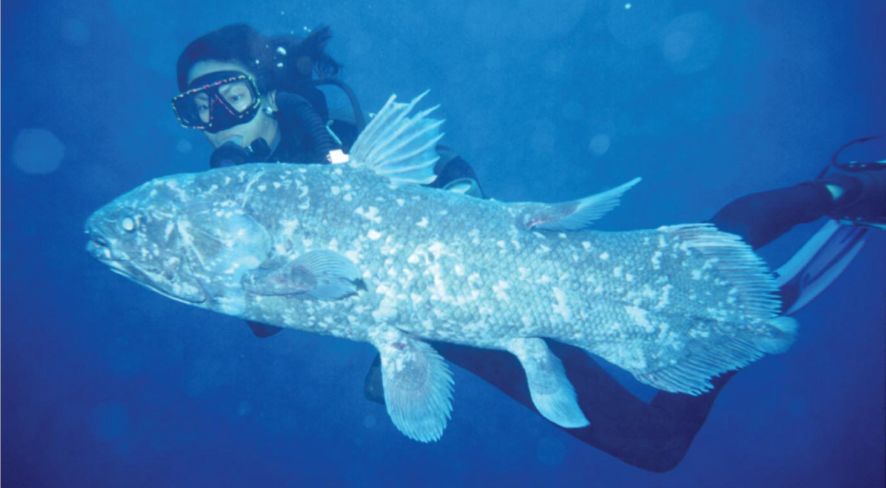The evidence is very compatible and consistent with what God says in Genesis. You will be amazed with the following article. We have added the latest pictures to assist you in the reading and understanding the issues.
Adapted from The Creation Answers Book, Chapter 19.
In Chapter 15, we saw how, according to an evolutionary long-age interpretation of the fossil record, many fossils are ‘out of place’. That is, they do not fit the supposed bottom-to-top progressive order of appearance claimed by evolutionists.
‘Out-of-sequence’ fossils are a challenge to theories of dinosaur evolution, too. For example:
- The fossilized remains of a small dinosaur (psittacosaur) have been found in the belly of a fossil mammal named Repenomamus robustus. This specimen, and another newly-discovered large Repenomamus fossil, are a real surprise for evolutionists because evolutionary assumptions say that mammals living during the so-called ‘age of the dinosaurs’ had to be small to avoid the huge reptiles. While a surprise for evolutionists, it’s no shock to creationists—mammals, dinosaurs and man originally lived at the same time.
- Another evolutionary idea that only tiny, shrew-like mammals lived with the dinosaurs was overturned when a fossil of a beaver-like mammal unearthed in Inner Mongolia was dated by evolutionists to 164 million years. By evolutionary reckoning, that is around 100 million years before dinosaurs are said to have died out.
 |
| A fossil mammal with the remains of a small dinosaur in its belly. |
- Dinosaur fossils are often found in rock strata containing few plant fossils, yet there must have been huge amounts of vegetation to feed the large herbivorous dinosaurs such as Brachiosaurus. However, from a creationist perspective, there’s no mystery. The dinosaurbearing strata do not represent a buried ecosystem or dinosaurian ‘age’—rather, dinosaur-bearing strata are simply rocks that have hardened around dinosaurs buried during the Flood. One might expect that the mobility of the dinosaurs compared to the plants would mean that they were not buried together—the dinosaurs would try to escape the rising floodwaters, whereas the plants could not.
 |
| A Brachiosaurus compared to a 1.8m man |
- Evolutionary researchers who discovered the remains of at least five types of grasses in dinosaur coprolites (fossilized dung) say ‘it was a complete shock’. It was a shock because according to the standard evolutionary line, based on a long-age fossil record ‘chronology’, grasses evolved around 55 million years ago, which would be 10 millions years after the extinction of the dinosaurs (supposedly) around 65 million years ago. But the discovery that dinosaurs ate grass left evolutionists with a dramatic grassy ‘timetravel’ conundrum: how could dinosaurs have eaten something that supposedly hadn’t yet evolved?
 |
| Coprolites found with rice plants inside |
- The popular evolutionary idea that dinosaurs were the ancestors of birds contradicts itself, as, according to their own dating, fossils of ‘bird-like dinos’ (the supposed precursors of birds) are millions of years younger than the famous fossil Archaeopteryx, which was a fully developed flying bird. Even fossils of the beaked bird Confuciusornis are older than its supposed ancestors.
 |
| Confuciusornis |
- The extinction of the dinosaurs is a great mystery for secular science. Little wonder, then, that it has so captured the attention of popular culture. Various evolutionary theories have been mooted as explanations for the demise of the dinosaurs, e.g. mammals appeared and ate dinosaur eggs; new narcotic plants evolved; and global cooling/warming. However, by far and away the most popular idea is that an asteroid impact was responsible. But that notion has insurmountable difficulties. For example, (evolutionary) extinction dates don’t correlate with (evolutionary) crater dates; and the famous iridium layer found in rocks worldwide—supposedly a key proof of meteor impact—is much less clearly defined than was once claimed.
 |
| Archaeopteryx |
From a biblical perspective, there is no dinosaur extinction ‘mystery’—the sedimentary rock layers containing fossils are not a ‘record’ of evolution and extinction over a millions-of-years timeframe, but rather a legacy of burial in the global Flood (around 4,500 years ago) and its aftermath. All the kinds of land animals (including dinosaurs) and birds survived aboard the Ark, repopulating the Earth afterwards. Since then, many creatures have gone extinct, not just dinosaurs, in an ongoing display of the Curse on Creation. Just as with the dodo, it’s likely that some dinosaurs perished through human influence, e.g. because of being a direct threat to man’s safety or because of loss of habitat (to agriculture or urban encroachment).
A modern parallel can be seen in that the tiger, the rhino and the elephant have either died out or are on the ‘endangered species’ list in many parts of South-East Asia through the ongoing post-Babel dispersion of man. Heroic accounts of brave young men in Indonesia slaying ‘rogue’ tigers and elephants bear a striking parallel with centuries-old stories of ‘St George and the Dragon’, Beowulf, etc, where the dragonslayers were also protecting others.
Some might wonder how people could kill some of the larger dinosaurs without modern weapons. But people killed whales that were larger than any dinosaur, from sailing boats, using team work and hand launched harpoons. And this on the whales’ ‘home turf’. Hunters have used such things as fire, traps and curare to capture/kill large animals.
 |
| Whale hunters without modern weapons |
The drying out of the continents after the Flood—all continents once had extensive inland seas—could also have been a factor in the demise of the dinosaurs. It seems that dinosaurs were like hippos, inhabiting areas with plenty of water, and the drying out of the land resulted in a contraction of areas suitable for them. The wax and wane of the post-Flood Ice Age (Chapter 16) would have also impacted dinosaur survival.
Thus dinosaur extinction is readily understandable from a biblical perspective.
Interestingly, according to an evolutionary interpretation of the fossil layers, lots of other organisms became extinct millions of years ago, e.g. the coelacanth (sometimes referred to as the ‘dinosaur fish’ because it was said to have become extinct around 65 million years ago), and the Wollemi pine (also known as the ‘dinosaur tree’ for the same reason). But evolutionists were surprised when these, and many other ‘living fossils’ or ‘Lazarus taxa’ were found to be still living today. Such discoveries did not surprise creationists. Similarly, it would not be a surprise if someone happens to find a live dinosaur today, e.g. in the remote jungles of the Congo or Papua New Guinea. But for evolutionists, the shock would greatly exceed that experienced when the coelacanth and the Wollemi pine were discovered to be still living today.
 |
| Coelacanth fossil |
 |
| Coelacanth alive today |
 |
| Wollemi Pine fossil with a living pine |
 |
| Marcellin, a Congolese biologist, showing Mokele Mbembe, a dinosaur, when he was in the swamp of Congo |
Postscript
Carl Werner has produced an excellent DVD entitled "Living Fossils" that clearly shows that the so-called fossilized animals, insects, birds, invertebrates, plants and dinosaurs are in existence in our world today. Read here for more details.
Also you can download to listen to a radio interview by Bob Enyart with Dr Werner here on "Living Fossils" and you can also get to read more details of Dr Werner's production at the same page.
The theory of evolution is nothing but a strong delusion, but a very nasty one, because of the shapeshifting factors and the ever changing 'understanding' of it. The most striking contradiction is the supposed evolution verses their own stasis hypothesis. The theory is also kind of molding into whatever seems neccesary...
ReplyDeleteI would not be surprised if they suddenly change their minds and think nothing much of it if dinosaurs would be alive now. Just look at the Coelacanth, as soon as it is discovered they dive into it to see what damage control they can do to their theory. The Coulacanth was a vital part of the diagram that allows for fish to change into landanimals. But now only some tetrapods are supposedly responsible for that... not anymore:
'Tetrapods from Poland trample the Tiktaalik school of evolution
by Tas Walker
Published online: 14 January 2010(GMT+10)
Subsequently published in Journal of Creation 24(1)
From Wikipedia.org
Lobe-finned fish and amphibians, according to evolutionary order
Figure 1: This neat fish-to-animal transition has been transformed from an evolutionary icon into an evolutionary dead-end. Click to see larger image.
Tracks of footprints found in a quarry in Poland have turned the palaeontological world upside down.1 For years there has been a neat evolutionary story about how fish evolved four legs and came out of the ocean onto the land (figure 1). Probably the most famous fossil in this sea-to-land icon of evolution is Tiktaalik roseae, a fish with fins that was claimed to have had features intermediate between fish and tetrapods. Creationists consistently rejected the evolutionary spin put on the fossil and showed that it had nothing to do with any alleged sea-to-land transition (see Tiktaalik roseae—a fishy ‘missing link’ and Tiktaalik—sticking its head out of water?). All the same, evolutionists promoted Tiktaalik relentlessly. It has its own website,2 features in evolutionary diagrams (e.g. figure 1), stars on the covers of books about evolution3 and was even the theme of a song to promote evolution.4 Richard Dawkins, in his latest book The Greatest Show on Earth, claims “Tiktaalik is the perfect missing link—perfect, because it almost exactly splits the difference between fish and amphibian, and perfect because it is missing no longer.” (See forthcoming book refutating Dawkins’ book.)'